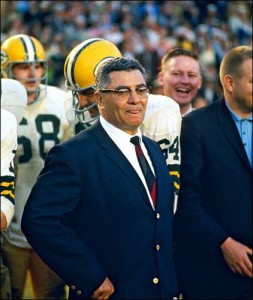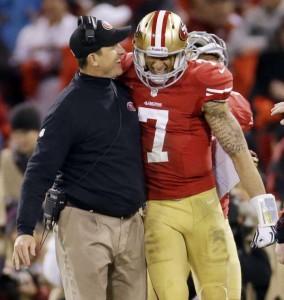Two years ago, the 49ers were 6-10 and floundering; they had the 5th worst record in the league from 2004 from 2010 in the pre-Jim Harbaugh era. Today, San Francisco possesses arguably the NFL’s most talented roster and best coaching staff, but is coming off a painful loss in the title game.
When I look at the 49ers, it’s hard not to see the striking similarities to an incredible turnaround executed 52 years ago. From 1953 to 1958, the Green Bay Packers were one of the league’s most poorly-run franchises. The team won just 20 games over that six-year period, the second fewest in the league. Vince Lombardi arrived in 1959, and the Packers won the NFL’s West Division in 1960, losing in the final seconds in the title game that year to Philadelphia. It was a heartbreaking loss, but the Packers used that game as motivation to win NFL titles in ’61, ’62, ’65, ’66, and ’67, with the latter two coming in the Super Bowl.
In 2011, I read and reviewed John Eisenberg’s excellent book That First Season: How Vince Lombardi Took the Worst Team in the NFL and Set It on the Path to Glory. Eisenberg looked at a subject that always fascinated me: the 1958 Packers, despite being the worst team in the league, had seven future Hall of Famers.
The table below shows the starting lineups for the 1-10-1 ’58 Packers, the team in Lombardi’s first year, and the roster in ’60 that went to the NFL championship game. On offense, only one of the eleven starters on the 1960 team was actually acquired by Lombardi, who traded for LG Fuzzy Thurston in the summer of ’59. Four of the starters — quarterback Bart Starr, running back Paul Hornung, receiver Max McGee, and center Jim Ringo — were also starters in 1958, the last pre-Lombardi year. The remaining six starters on the ’60 team were all on the roster before Lombardi arrived: RB Jim Taylor (’58 draft), WR Boyd Dowler (’59 draft) [1]Back in those days, the draft actually took place at the end of the prior season. The 1959 draft was completed over a month before Lombardi came to Green Bay., TE Gary Knafelc (on the team since ’54), LT Bob Skoronski (’56 draft), LG Jerry Kramer (’58 draft), RT Forrest Gregg (’56 draft). The “green” rows show the players that were starters pre-Lombardi, while the yellow rows represent those players on the Green Bay roster Before Vince:
On defense, all three linebackers and defensive tackle Dave Hanner were starters in 1958. Once he arrived, Lombardi then picked up three defensive starters from Cleveland. Lombardi chose to unload Billy Howton for various reasons in exchange for Browns defensive end Bill Quinlan. He also added defensive tackle Henry Jordan from Cleveland in ’59, and went back to the Browns for defensive end Willie Davis in ’60. (Coincidentally, Jason just published his excellent interview with Davis here, promoting his book Closing the Gap.)
In the secondary, Lombardi brought in Emlen Tunnell, whom he had coached with the Giants, and switched the positions of Hank Gremminger and John Symank. Cornerback Jesse Whittenton had been with the Packers in ’58, and moved into the starting lineup in Lombardi’s first year. The takeaway: of the 22 starters on the 1960 team that went to the NFL title game, 10 were starters on the ’58 squad that went 1-10-1, and another seven were backups on that same team. Yet those players formed the foundation for the team of the ’60s. [2]Lombardi also drafted Willie Wood in 1960, a future Hall of Famer who was a punt returner as a rookie and a fixture at safety the rest of the decade. Then in ’61 he drafted Herb Adderley. … Continue reading
It’s hard not to draw the similarities to Harbaugh’s 49ers. In fact, Harbaugh inherited even more starters on his first team to make the title game than Lombardi did. If not for the switch at quarterback, the 2012 49ers offense would have only three new starters compared to the 2010 version that went 5-10 under Mike Singletary. The second wide receiver position has been a revolving door opposite Michael Crabtree, and will likely feature a new face soon (perhaps first round pick A.J. Jenkins). The other two new starters are on the offensive line: Center Jonathan Goodwin was picked up from New Orleans, while RG Alex Boone was on the team before Harbaugh arrived (and has now blossomed into one of the game’s best guards).
Like Lombardi, Harbaugh deserves credit for unlocking the potential in a host of players he inherited. San Francisco has become the most talented team in the league not because Harbaugh was able to find new players (with one obvious exception), but because he and his staff maximized what they inherited. Lombardi’s tale is similar: yes, the team he inherited was 1-10-1, but they also featured seven Hall of Famers (and Jerry Kramer). Of course, at the time, no one much of Starr, Hornung, Taylor, Gregg, Kramer, or Nitschke. Of the other two future Hall of Famers, Ringo was an established star pre-Lombardi, but Len Ford retired after the ’58 season. Harbaugh knew he inherited great players in Willis, Gore, Davis, and Smith, but he’s maximized the talents of Staley, Iupati, Boone, Bowman, McDonald, Crabtree, Brooks, and Brown.
Like Lombardi, year two for Harbaugh ended in painful fashion. But his team is full of young players that could set the stage for a dynasty. Look at the list of players on the 49ers roster who were 25 or younger in 2012: Colin Kaepernick (25), LaMichael James (23), Kendall Hunter (24), Michael Crabtree (25), Mike Iupati (25), Alex Boone (25), Anthony Davis (23), Aldon Smith (23), Navorro Bowman (24), and Chris Culliver (24). And players like Patrick Willis (27), Joe Staley (28), Dashon Goldson (28), and Vernon Davis (28) are still in the primes of their careers. For many in 49ers nation, today is a very painful day. That just makes the similarities between Jim Harbaugh and Vince Lombardi even more striking.
References
| ↑1 | Back in those days, the draft actually took place at the end of the prior season. The 1959 draft was completed over a month before Lombardi came to Green Bay. |
|---|---|
| ↑2 | Lombardi also drafted Willie Wood in 1960, a future Hall of Famer who was a punt returner as a rookie and a fixture at safety the rest of the decade. Then in ’61 he drafted Herb Adderley. Dave Robinson, the newest member of the Hall of Fame, was added in 1963. |


